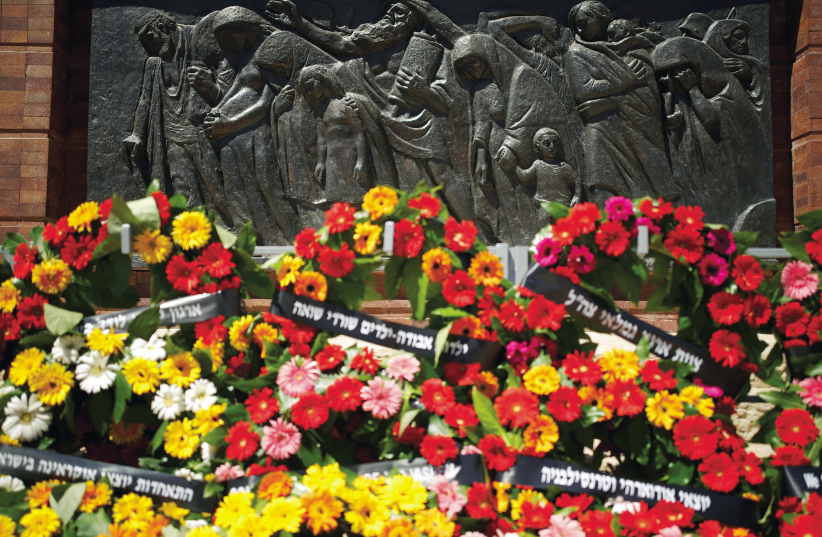"The passage of time in no way diminishes the criminal responsibility of those guilty of aiding and abetting the implementation of the Final Solution," Ephraim Zuroff, the Israeli-based director of the Simon Wiesenthal Center, told The Jerusalem Post on Wednesday.Ninety-two-year-old Bruno Dey was charged with aiding and abetting the murder of over 5,000 people as a Nazi death camp guard and the Simon Wiesenthal Center is in support.
He credited a change in policy instituted ten years ago for the trials of four former Nazis. "Now, any person who served in a death camp or mobile killing unit can be prosecuted in Germany based on service alone," Zuroff told the Post. He said such a policy existed before it was changed in the 1960s, requiring proof that a Nazi had actually committed a specific crime against specific victims motivated by racial hatred.
Dey served as a guard at the Stutthof concentration camp in Nazi-occupied Poland during World War II. The nine months he spent on duty at a concentration camp watch-tower led to the murder of 5,230 civilians, Reuters reported a month ago. According to the German Die Welt newspaper, which first reported the charges, the man admitted to prosecutors during a voluntary interrogation last year that he had seen people being taken to gas chambers to be murdered, but said there was nothing he could do to stop it. Prosecutors in Hamburg accused Dey of assisting in the "malicious and cruel" killing of mostly Jewish inmates at the camp between August 1944 and April 1945, Germany said. They did not release the suspect's name.Dey will be tried as a juvenile since he was 17-18 years old when he served as a guard. He was described as a "little wheel in the machinery of murder," by prosecutors, according to Ynet.
"The Wiesenthal Center has assisted in the recent cases of two Stutthof guards by locating more than 20 survivors of the camp, most of whom are currently residing in Israel," Zuroff stated regarding the case.
He noted that German authorities convicted three former Nazis based on the new policy and two out of the three cases had their appeals rejected.
"This will be the fifth trial when it begins," he told the Post. "Had this change been made previously, it would have greatly increased the number of perpetrators to go to trial," he added.
The other war criminals to stand trial for the murder of over 6 million Jews and millions of other minorities include Oskar Groening, known as the "Bookkeeper of Auschwitz" for his job counting cash stolen from people. He died last year aged 96 as he waited to begin his sentence.
In 2016 Reinhold Hanning was sentenced to five years in prison for being an accessory to the murder of 170,000 people as an Auschwitz death camp guard.
Founded in 1977, the Simon Wiesenthal Center educates the public about the Holocaust. It was named after the famed Nazi-hunter.About 115,000 prisoners passed through Stutthof during World War II, according to the Yad Vashem Holocaust memorial museum and research center. More than half of the prisoners, about 65,000, died there, and 22,000 were transferred to other camps.The camp started as a civilian labor camp and was converted into a concentration camp in January 1942. Most of the prisoners at the beginning were not Jewish, but large groups of Jews began arriving in 1944, mainly women from Auschwitz and labor camps in the Baltic states.Conditions at the camp were unbearable. Prisoners were forced to do hard labor and starvation and disease ran rampant. Those wounded or too sick to work were sent to the gas chamber. Wounded and sick prisoners who were recuperated in the camp infirmary were often killed by camp doctors."Stutthof was a camp what it was a lot of people died over there, not just what they shoot them, but from cold and from hunger and from dirt," said Zelda Moyal in a testimony about Stutthof recorded on Yad Vashem's website. "And every hour, every other hour they took all the women at night or in the daytime or in the middle of the day to stay everybody one near the other and this was like a punishment, just to stay in the cold with one dress with stripes and dirty with lice - kinim - and not to eat and drink - a lot of people died there, without shooting them.""The number of inmates decreased. People died like flies," said Dora Love in a testimony about Stutthof recorded on Yad Vashem's website. "After the first couple of days, you were being lined up to go to work or by that time, some looked worse again and so the number got smaller. It was again right, left, right, left...Stutthof was a total extermination camp." In January 1945, as the Soviets approached, about 50,000 surviving prisoners were sent on death marches. Tens of thousands died or were murdered along the way.The camp was liberated by Soviet troops on May 9, 1945.
